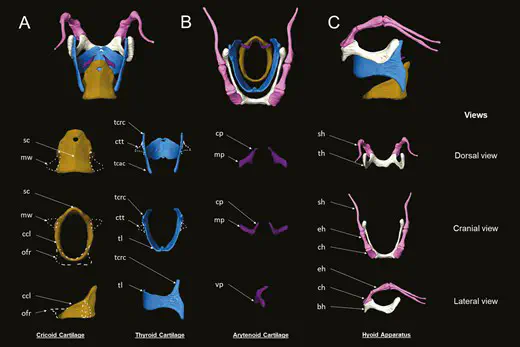Comparative anatomy of the vocal apparatus in bats and implications for the diversity of laryngeal echolocation

Abstract
Most of over 1400 extant bat species produce high-frequency pulses with their larynx for echolocation. However, the debate about the evolutionary origin of laryngeal echolocation in bats remains unresolved. The morphology of the larynx is known to reflect vocal adaptation and thus can potentially help in resolving this controversy. However, the morphological variations of the larynx are poorly known in bats, and a complete anatomical study remains to be conducted. Here, we compare the 3D laryngeal morphology of 23 extant bat species of 11 different families reconstructed by using iodine contrast-enhanced X-ray microtomography techniques. We find that, contrary to previously thought, laryngeal muscle hypertrophy is not a characteristic of all bats and presents differential development. The larynges of Pteropodidae are morphologically similar to those of non-bat mammals. Two morphotypes are described among laryngeal echolocating bats, illustrating morphological differences between Rhinolophoidea and Yangochiroptera, with the main variations being the cricothyroid muscle volume and the shape of the cricoid and thyroid cartilages. For the first time we detail functional specialization for constant frequency echolocation among Rhinolophoidea. Lastly, the nasal-emitting taxa representing a polyphyletic group do not share the same laryngeal form, which raises questions about the potential modular nature of the bat larynx. Brualla, N.L.M, Wilson, L.A.B., Tu, V.T., Nojiri, T., Carter, R.T., Ngamprasertwong, T., Wannaprasert, T., Doube, M., Fuki, D., Koyabu, D.
Zoological Journal of the Linnean Society (2024)